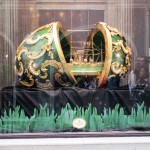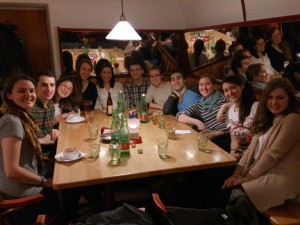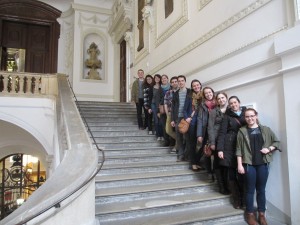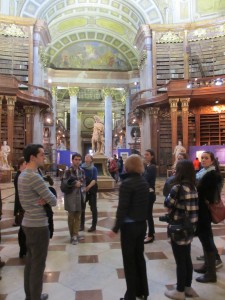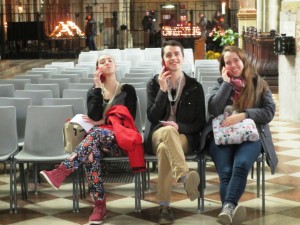Here are excerpts of what some of the Dickinson-in-Bremen students said about our recent trip to Vienna.
Margaret:
What I enjoyed the most of the activities on my own was visiting the Kunsthistorisches Museum, or the Museum of Art History. By virtue of studying abroad for a full year, I’ve been to almost more museums than I can count throughout the past months. Yet the Kunsthistorisches Museum in Vienna was one that definitely stood out in its singularity. My plans to only spend half the day there were quickly forgotten when I spent the entire morning in the single Kunstkammer wing, a twenty gallery-exhibition similar to a treasury, holding hundreds of years worth of Hapsburg possessions and collections where the unique diversity of the artifacts matches the depth of decades from which they span. I saw busts, paintings, porcelain figures, shimmering gems and jewelry, tapestries, clocks, carved ivory chests, oddities the likes of which I’ve never seen before (such as a giant drinking goblet made of an ostrich egg and carved jade), and countless more treasures I’ll likely never see an equal to. In addition, the museum houses the art collections of the House of Habsburg, filling almost
the entire second floor. As someone who likes to take their time through art museums and give attention to each piece, imagine my struggle upon walking into spacious galleries where almost every inch of the tall walls were covered with paintings. Despite the near impossibility of laying eyes on every single piece, the stunning collections still imparted a lasting impression of the country’s vast cultural heritage.
Devon:
One of the most surprising moments for me was the realization that one of my favorite parts of the trip was the opera. I am very uneducated in opera and have only ever been to one in my life. But our evening at the opera was by far the best experience I had in Vienna. The fact that the script was posted on screens that flanked the stage was extremely helpful, considering I know very little (read as: absolutely zero) Italian. Furthermore, the text did not seem extremely difficult, I certainly understood more than 75% of the words and I knew what was happening throughout. It was certainly a point of pride for me and I felt much more confident in my speaking and understanding of German following the opera.
My time in Austria was well-spent. I saw many sights, many museums, and many animals. But more than anything else, I think Austria strongly benefitted my German. I spoke more in those 4 and a half days than I had since my language-intensive course ended. By the end of the trip, I felt extremely confident in my language and some of my trepidation to speak in public was relieved. It certainly gave credit to the oft-given advice that the best way to improve your language speaking skills is to dive right in; try your best to ignore the voice in your head telling you how wrong you may be or how afraid you are and just speak. More often than not, you’ll do better than you expected of yourself and that is the easiest way to improve your confidence and furthermore, improve your speaking skills. Austria did a wonderful job and that, and the impression it left upon me, won’t soon be forgotten.
Lucia:
 In my free time in Vienna I chose to visit two art museums: Hundertwasser Museum and the Belvedere. After taking interest in Hundertwasser’s style and life philosophy in a German course a few years ago, I was eager to see his architecture in person. The Hundertwasserhaus is a perfect example of the architect’s style– colorful and organic in design while maintaining functionality. Moving on to the Hundertwasser Museum just around the corner, I was pleasantly surprised by the variety of his works on display. The museum features Hundertwasser’s paintings coupled with architectural plans/models all scattered throughout quotes and information about the artist’s life. The building itself is also one of Hundertwasser’s own design. The floors are uneven and small nooks allow plants to grow up the sides of the walls. I was truly intrigued by the progression of his artistic style and different ideas for functional structures. In contrast, the Belvedere is a lavish museum/palace housing a great variety of art. I had chosen to visit the Belvedere with hopes of seeing some of the Viennese artist Gustav Klimt’s works. Stepping onto the grounds, I was first amazed by the size and grandeur of the museum. Seeing a few of Klimt’s pieces in person (and in such a grand setting) was certainly a memorable experience. Overall I quite enjoyed the differences between the museums and would have loved the chance to spend more time in both.
In my free time in Vienna I chose to visit two art museums: Hundertwasser Museum and the Belvedere. After taking interest in Hundertwasser’s style and life philosophy in a German course a few years ago, I was eager to see his architecture in person. The Hundertwasserhaus is a perfect example of the architect’s style– colorful and organic in design while maintaining functionality. Moving on to the Hundertwasser Museum just around the corner, I was pleasantly surprised by the variety of his works on display. The museum features Hundertwasser’s paintings coupled with architectural plans/models all scattered throughout quotes and information about the artist’s life. The building itself is also one of Hundertwasser’s own design. The floors are uneven and small nooks allow plants to grow up the sides of the walls. I was truly intrigued by the progression of his artistic style and different ideas for functional structures. In contrast, the Belvedere is a lavish museum/palace housing a great variety of art. I had chosen to visit the Belvedere with hopes of seeing some of the Viennese artist Gustav Klimt’s works. Stepping onto the grounds, I was first amazed by the size and grandeur of the museum. Seeing a few of Klimt’s pieces in person (and in such a grand setting) was certainly a memorable experience. Overall I quite enjoyed the differences between the museums and would have loved the chance to spend more time in both.
Joan:
We began Tuesday with a visit to Schönbrunn Palace, the former imperial palace in Vienna. It was a beautiful palace and quite interesting to wander around and learn about the different Kaisers who lived there, especially Kaiserin Maria Theresia. After the audio tour we went behind the palace, through the gardens, to the stunning gloriette where we ate at the café there and enjoyed the beautiful day. After that, Anna, Lucia, Paul, Sean, Shuwei, and I headed to the Hundertwasserhaus, an apartment building designed by Friedensreich Hundertwasser. I remembered learning about Hundertwasser in my 201 class, but I forgot that some of his buildings were in Vienna, so when I learned they were
nearby, I made sure to go see them. We then walked a few blocks to the KunstHausWien, another building designed by Hundertwasser that houses a lot of his artwork. Going through the museum, I never realized what an environmentalist Hundertwasser was. He reminded me of a 20th century artist version of John Muir. The great thing about KunstHausWien is that the building was designed by the same artist whose artwork is on display, so there is a real continuity between the art and the building. The only thing that threw me off was on the top two floors were an exhibition of large, mostly black and white photographs. It was a nice exhibition, just the stark contrast with the rest of the building made it hard for me to get out of the Hundertwasser mindset while looking at very different art. On the first floor of the museum was a vegetarian restaurant (also designed by Hundertwasser) where we had dinner. Afterwards we went to the Wien Konzerthaus and were able to get student tickets to see Bach’s “Johannespassion.” Our seats were right in the front middle of the balcony, so we could see and hear really well. There was an orchestra, four main singers, and a boy’s chorus. All in all, the concert was great!
Paul:
One thing that was immediately apparent to me during my visit to Vienna was how intentionally the city itself was structured. This intentionality was manifest in the regularity of the buildings, their almost overwhelming whiteness, and in the way they were honeycombed around the Habsburg edifices. The place really looked like the seat of an empire.
I think that these observations helped me to appreciate my favorite Vienna experience – my visit to Kunst Haus Wien, the Friedensreich Hundertwasser museum – even more. Don’t misunderstand me, the dominant rococo and baroque architecture was beautiful and impressive; but Kunst Haus Wien, which Hundertwasser himself designed, exhibited the same level of intentionality while preserving the organic beauty unique to Hundertwasser’s artistic and philosophical outlook. I had heard of Hundertwasser in classes at Dickinson, and I had also seen a number of his prints, all of which I thought were really beautiful and unique. It turned out that some of the other Dickinsonians had as well, so we decided to visit the museum. The building’s face is divided into irregularly shaped, colored blocks. Its pillars and entranceway are littered with varying mosaics. When one walks through the door, he is struck by the fact that the floor itself is not flat. Instead, its clay exhibits undulations and repeats the mosaic motif. A sign on the wall indicates that Hundertwasser made this choice because the earth’s unadorned crust actually presents us with the same sorts of rises and divvies, and further because they can serve as a source of excitement for the feet. So, even on the first step through the door, one sees (and feels) Hundertwasser’s back-to-nature, organic vision. Kunst Haus Wien often presents the organic world even more directly: the place is a veritable forest. And then there are all of Hundertwasser’s incredible paintings, woodcut prints, and architectural models. The models represent more ambitious imaginings of the themes expressed in the museum’s architecture. Hundertwasser had planned whole communities with his ideals in mind. In these communities, the line between artifice and nature is constantly blurred. Streams and roads take similarly meandering routes around homes constructed in hills. Trees abound. The windows and walls that one does see have the color and irregularity of all of Hundertwasser’s work. This might sounds like chaos, but I was really struck by how functional and logical these communities looked. Utopian ideals are often accused of impracticality, but I’d have a hard time lodging this complaint against Hundertwasser. His work didn’t look contrived or forced, but rather exhibited the same kind of beautiful regularity we find in the natural world, in tree rings or spider webs or even frog spawn. And I appreciate this kind of regularity and beauty much more than the silk, gold and marble of Schönbrunn.
Sean:
Two places I chose to visit in the allotted free time were the Kunst Haus Wien and Belvedere Palace. Both were important destinations for me because of my love for Friedensreich Hundertwasser und Gustav Klimt, whose works were displayed in the two locations respectively. Kunst Haus Wien had an incredible amount of work by Hundertwasser and a unique layout and floor plan that made the experience even more interesting. Most notably was the unevenness of the floor. Hundertwasser wrote that:
“An uneven and animated floor is the recovery of man’s mental equilibrium, of the dignity of man which has been violated in our levelling [sic], unnatural and hostile urban grid system. The uneven floor becomes a symphony, a melody for the feet and brings back natural vibrations to man. Architecture should elevate and not subdue man. It is good to walk on uneven floors and regain our human balance.” Hundertwasser, April, 1991
The second place I visited was Belvedere Palace. Belvedere Palace was a great experience for two reasons: the location was incredibly interesting and rich with history and the palace also housed several of my favorite paintings. After spending a considerable amount of time wandering the palace admiring the works of art from different eras, I ended in the Gustav Klimt room. I have been a fan of Klimt’s for some time, especially of his most famous work The Kiss (Lovers). Never before was I unable to look away from a painting for so long. Klimt managed to capture an amazing moment of intimacy in the painting, which elicited a response in me I haven’t experienced with a painting before. Overall, it was an extremely rewarding experience.
Shuwei:
Our trip to Vienna was amazing! We’ve been to many great places, including Stephansdom, Schönbrunn, Mozarthaus, National Bibliothek, etc. What interested me most is the music culture and history in Vienna. Before going, my impressions about Vienna were all about music. It is the city where many masters of classic music had worked – Mozart, Beethoven, Haydn… We visited Mozarthaus in which Mozart lived for three years, and two of his most famous musical operas, “Don Giovanni” and “The Marriage of Figaro” were written during this time. The museum displayed many original musical scores, documents and also furnitures about Mozart, trying to show Mozart’s personal life and musical compositions in Vienna. Although some details are vague today, I can still imagine how Mozart was enjoying his time in this house. There’s also many documents showing Mozart’s close friendships with other musical masters in Vienna. Reading through these documents, it’s not hard to imagine the prosperity of music in Vienna during that time. After visiting Mozarthaus, we went to the Theater an der Wien for his opera “Don Giovanni”. This is probably the best live opera I’ve ever seen. The music, the singers, the setting of the theater and even the audiences were gorgeous. No seats were empty, and thinking of the other two nights when we had concert and drama, the houses were also full. It surprised me how Vienna people enjoy going to concerts and theaters. Through these music activities and experiences, I felt really close to this city and learned more about its culture and history.

